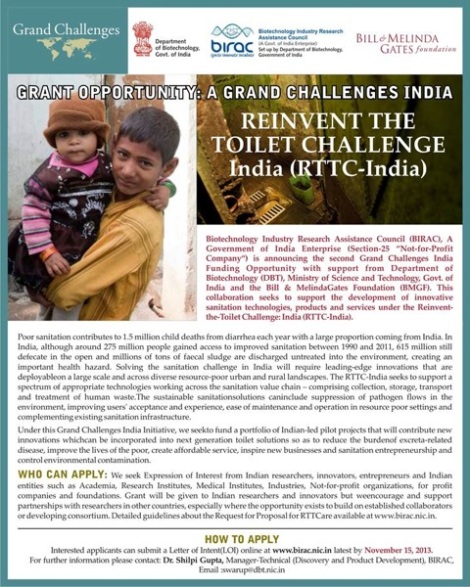A faecal challenge across India
A few years ago the Indian Railways launched the ‘bio-toilets’ scheme to ensure faeces-free tracks and make its trains less smelly. At present, it is running 1,400 coaches with 3,800 bio-toilets in various trains, and plans to boost the effort by covering more trains this year—a great relief indeed for the huge populace that this mode of transport ferries across the country.
Healthy toilets are the necessity of the hour and India needs more such new ideas in its basket to pick and chose the right one.
Open defecation and poor sanitation are India’s shame. Both in rural and urban areas, a major portion of our population either defecate in the open or simply store their waste, with no sustainable way to handle it once their on-site storages—such as a septic tanks or latrine pits—fill up.
We need innovative solutions that will suit the people, be affordable, environment friendly, sustainable, water saving and manageable. We need technologies to empty toilets before they pile up to a level that can affect people’s health, life and property.
Forty per cent of the world’s population—2.5 billion people—practice open defecation or lack adequate sanitation facilities, and the consequences can be devastating for human health as well as the environment.
Even in urban areas, where household and communal toilets are more prevalent, 2.1 billion people use toilets connected to septic tanks that are not safely emptied, or use other systems that discharge raw sewage into open drains or surface waters.
In India, although around 275 million people gained access to improved sanitation between 1990 and 2011, 615 million still defecated in the open in 2011 (WHO and UNICEF 2013) and millions of tonnes of faecal sludge collected from pit latrines and septic tanks are discharged untreated into the environment, creating an important health hazard.
Solving this problem requires researchers committed to take up this challenge. They also need support to dedicate themselves to bring about innovative solutions. Responding to this need, we have called for proposals from those who think on these lines.
Our aim is to support talented researchers to conceptualise prototype and field-test highly innovative ways to process human waste for sanitation service delivery.
This is the first programme under the Memorandum of Understanding between the Bill & Melinda Gates Foundation (BMGF) and the Department of Biotechnology (DBT), signed last year, to collaborate on mission-directed research to support health research and innovation.
It aspires to boost to the government’s Nirmal Bharat programme, with dreams of a clean and healthy nation that thrives and contributes to the well being of our people and the habit of open defecation is entirely eliminated.
We hope to attract innovative new ideas as well as build on some great efforts that have taken place.
For example, IIT-Kanpur has developed a cheaper “zero-discharge” toilet that will separate 90 per cent of the liquid from the waste and reuse it for flushing.
The DRDO has also developed a novel bio-toilet technology. The brave and determined in the Central and State Governments, as well as several dedicated NGOs are addressing this problem and have been doing so for a while.
It is due to their efforts that we have at last some levels of sanitation in place and are perhaps inching ahead and not slipping back.
It’s all very well for all us to point to the problem. Yet, the scale and complexity of the problem seems to defy an easy or comprehensive solution.
When asked to suggest one, most scientists will say that science and technology have no substantive role here and the problems and their solutions lie in the realm of sociology and economics.
Indeed, many might say that the technologies for toilets already exist and all we need to do is to implement them. Real life is a lot more complex.
Effective solutions emerge from a barrage of ideas. They will also have to be scalable and they need to be designed, prototyped and field- tested. Finally, they must be attractive to entrepreneurs and industry and attractive (yes!) to users.
We are eagerly looking forward for some zany ideas from talented young researchers to see the light of day!
Read on about the call for proposals from the DBT, BIRAC and the Bill and Melinda Gates Foundation and take a look at the attached advertisement. And do apply! Let’s work together to clean up and better all our lives. Gandhi Jayanti is a great day to start.
Links to help your application



Hi Vijay, ePromis interface is very messy as it stands. Is it not possible for it be work like a manuscript submission interface, enabling the author to submit a full text document of the proposal organized in the format as specified by DBT with provisions for uploading images and tables as supporting documents wherever required? Also, it would be nice if ePromis runs on internet explorer as well, which is not the case right now. I did write to ePromis people on this a month ago, but there is no response. Best.
pradeep